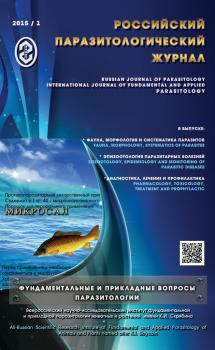В данной работе представлены результаты исследований 442 проб фекалий крупного рогатого скота, буйвола и овцы на зараженность их гельминтами. Пробы фекалий были взяты на исследование у 171 гол. крупного рогатого скота, 128 буйволов и 143 овец. На основании результатов тестирования, проводимого в период с мая 2014 г. по апрель 2015 г., было установлено, что 81 из 171 гол. крупного рогатого скота (47.3%) показали положительный результат на наличие гельминтов, причем степень заражения коров (55%) была выше, чем у быков (40%). 41 из 128 обследованных буйволов показали положительный результат, а уровень заражения составил 32%. Таким образом, уровень заражения коров (47%) был выше, чем быков (22%). Самый высокий уровень инвазии был отмечен у овец. Исходя из полученных результатов можно сделать вывод, что уровень заражения крупного рогатого скота составил 50.3%. Нематоды семейства Trichostrongylidae являются доминирующими как у крупного рогатого скота, так и у буйволов. Уровень заражения женских особей был намного выше, чем мужских. В отношении сезонной динамики следует отметить, что самый высокий уровень заражения приходится на весенний период.
гельминты, распространение, жвачные животные, Trichostrongylidae.
Introduction
The aim of this work is to investigate the helminthes infesting ruminant animals in Sohag province, their incidence, prevalence, and the fluctuation of the infection rate during the different seasons. Parasites in livestock and other animals cause diseases that have a major impact on global socio-economic conditions. The current financial losses to agriculture due to parasites seriously reduce farm profitability. The annual cost associated with parasitic diseases in sheep and cattle in Australia has been estimated at $1 billion Australian [13] and [15] among livestock, ruminants are one of the sources of Egypt’s national income, with production of milk, meat, wool, hair, and hides. Moreover, their manure is a valuable soil fertilizer. Parasitic infections destroy our animal wealth and are the biggest hindrance to successful, profitable production. The percentage of field animals infected fluctuates with factors that include irrigation, season, frequency of exposure, immune condition, geographic location, and climate [7]. Professional livestock production is a business for profit. Parasitic infections adversely affect production, impairing the livelihood of the individual farmer and the entire industry [8], [9]. Thus, there are major economic gains to be made by taking measures to control important parasitic diseases. The current method to control Nematode parasites in livestock is use of chemotherapeutic agents (anthelmintics).
Even with strategic treatment, this method is costly and not always effective. The excessive use of anthelmintics has resulted in substantial and widespread problems with genetic resistance in nematode populations. There is a need for developing improved means of controlling these parasitic nematodes. Gastro intestinal tract (GIT) parasites are known to be widespread [10], [11]. They lead to acute illness and death, premature slaughter, and rejection of meat parts at inspection stations. Indirect losses include decreased growth rate, weight loss in young growing calves, late maturity of slaughter stock, and decreasing cattle production in many regions and countries [15]. The infections are either clinical or sub clinical; the latter is the more common and is of great economic importance [12] .Although clinical parasitism has received considerable attention because of its obvious severity, the study of parasitism in herds without clinical signs of infection has been largely neglected. [3] Demonstrate that G.I. nematodes are still widespread among adult cows in temperate climate regions, with a prevalent infection rate of between 80 and 100%. The most prevalent species found was Ostertagia ostertagi. Moreover, two reviews suggest that sub clinical gastro-intestinal Nematode infections in adult cows can have an adverse effect on milk production.
1. Abdel-Wahed, M.M. Morphological studies on G. I. nematodes infesting buffalo in Kalubia and Sharkia Governorates. M.V.Sc. Thesis, Cairo University.(1987).
2. Agye, A.D. Epidemiological Studies on Gastrointestinal Parasitic Infections of Lambs in the Coastal Savanna Regions of Ghana. J. of Tropical Animal Health and Production, Volume 35: 207-217. 2004.
3. Borgsteede, F.H.M Tibben, J. Cornelissen J.B. Agneessens, W.J. and Gaasenbeek, C.P.H. Nematode parasites of adult dairy cattle in the Netherlands, Vet. Parasitol. 89: 287-296. (2000).
4. Burger, H.J. and Stoy, M. Parasitologsche diagnostic (teil 11). Elzahlung und larven differenierung. Therapogen praxisdienst, 3:1-22. (1986).
5. Charles, M.H. (1998). Diagnostic vet. Paras. Second Edition. Page-254.
6. Chollet, J.Y. Martrenchar, A Bouchel, D Njoya, A. Epidemiology of digestive parasitic diseases of young cattle in northern Cameroon. Rev Elev. Medical Veterinary Pays Trop. 1994, 47(4):365-74.
7. Corwin, R.M. Economics of gastrointestinal parasitism of cattle. Vet. Parasitol. 1997, 72: 451-457.
8. Eysker, M. and Ploeger, H.W. Value of present diagnostic methods for gastrointestinal nematode infections in ruminants, Parasitology 2000, 120:S109-S119.
9. Ezzat, M.A.E. The geographical distribution and incidence of important parasitic diseases in Egypt and its bearing on the livestock production. J. Arab. Vet. Med.Ass, 1960, 20 (2):127-136.
10. Keyyu, J.D.; Egyne, E.; Makundi, A.E. and Kassuku, A.A. (2002) Comparative efficacy of Zoomectin and Ivomec Super against Gastrointestinal nematodes of sheep and goats, Tanzania Veterinary Journal 21: 291-9.
11. Keyyu, J.D.; Monrad, J.; Kyvsgaard, N.C. and Kassuku, A.A. Epidemiology of Fasciola gigantica and Amphistomes in cattle on traditional, small-scale dairy and large-scale dairy farms in the Southern Highlands of Tanzania, Tropical Animal Health and Production , 2005, 37: 303-314.
12. Makundi, A.E.; Kassuku, A.A.; Maselle, R.M.; and Boa, M.E. Distribution, prevalence and intensity of Schistosoma bovis in cattle in Iringa district, Tanzania, Veterinary Parasitology, 1998, 75: 59-6.
13. McLeod, R.S. (1995) Costs of major parasites to the Australian livestock industries, Int. J. Parasitol. 25: 1363-1367.
14. Pritchard, G.C.; Forbes, A.B.; Williams, D.J.; Salimi-Bejestani, M.R.; Daniel R.G. Emergence of fasciolosis in cattle in East Anglia. Vet Rec. 2005, 157(19):578-582.
15. Sackett, D. and Holmes, P. Assessing the economic cost of endemic disease on the profitability Australian beef cattle and sheep producers. Meat and Livestock Australia Limited, Sydney, Australia.2006,ISBN. 1741910021.
16. Shimaa, S.G. some studies in helminth parasites of abomasum of cattle and buffaloes in Kafr-Elsheikh province. M.V.Sc. Thesis, Kafr-Elsheikh University, 2005.
17. Van Aken, D.; Dargantes, A.; Valdez, L.; Flores, A.; Dorny, P.; and Vercruysse, J. Comparative study of strongyle infections of cattle and buffaloes in Mindanao, the Philippines. Veterinary Parasitology, 2000, 89: 1-2: 28-1.





